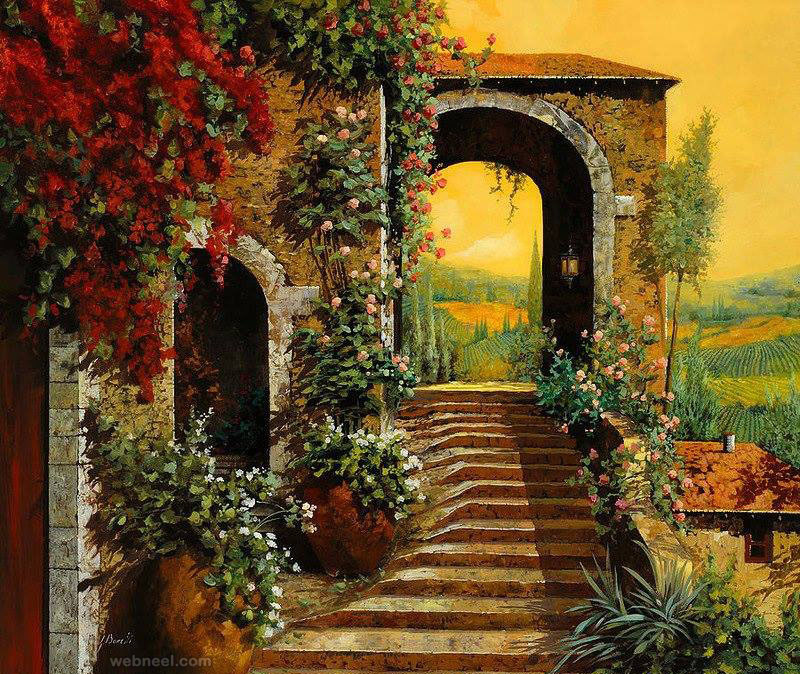

#Scenery paintings how to#
Meagan Smith, a junior studying costume design, said that negotiating with other painters on the final project was useful in learning how to adjust and compromise to get a seamless result. “My intentions are not just to make students work together, to enjoy the artistry in general, but also to learn something new about the artists of the original work and the time period,” she said. When she introduced the painting to the students, two weeks before the exhibition, she gave them a detailed history of Braque, his importance to Cubism and his influence on Picasso. Teplinskaya herself spent more than seven hours looking for the right image for the final class project. Allen’s cartoon transfer of Roger Rabbit took at least 24 hours of work, he estimated. “You learn the detail you need and the detail you don’t,” he said.īut that doesn’t mean the projects were a snap. He said the class was particularly useful for learning how to paint quickly and efficiently. “Theater is a collaborative art form,” he said, “and in this class you really learn how to work with a scenic designer.” Austin Allen, a junior studying lighting and projection design, said that what he learned will come in handy working on productions. In this class you really learn how to work with a scenic designer. “Vika holds designers accountable on choices made, always asking you, ‘What kind of wear and tear would there be on this building?’ or ‘What was inside this warehouse that you are painting?’ and makes you think about the specifics.” “I had no art background and I’m not a designer, but we learned so many techniques – and it all looks pretty convincing. “It’s such a great, practical class that relates with everybody involved in a production,” she said.

A favorite classĪlice Pollitt said the class had been her favorite at USC. Parents Byron and Teresa Pollitt of Tiberon, near Sausalito, snapped pictures and seemed a bit awestruck by the work their daughter Alice, a senior in stage management, had helped complete. “We are kind of astonished at seeing what our daughter produced,” Byron Pollitt said. “I don’t want them taking five hours on something I can show them how to do in five minutes,” she said. She’s brilliant at creating painted effects quickly and efficiently. She also trains them in techniques she’s learned working for theaters and production companies during the past 12 years. I don’t want them taking five hours on something I can show them how to do in five minutes. Teplinskaya, a graduate of the Moscow School of Fine Arts who holds a BFA in set design from the Russian Academy of Theatre Arts and an MFA in set design from California State University, Long Beach, teaches students how to use lighter, cheaper materials to imitate textures or create a specific decorative look. (The 2014 project, “Elysium” by Léon Bakst, takes up most of the building lobby’s north wall.) The still life will be framed and take its place in the entrance of McClintock Theatre on campus, along with final paintings from past years. The finished piece, 11 feet long, had to look as if only one artist had been at work.Īnd it did. The fledgling scenic painters had to match Braque’s style and colors, blending their section to those on either side. Braque’s painting, “Pitcher, Lemons, Fruit Dish,” was divided into eight vertical panels, one for each student. The final project was done as a group: a large copy of a 1928 still life by the French Fauvist Georges Braque. Parents and friends came to view the large-scale painted cartoon figures, the texture studies, the bricks, the wood grains and crackled paint. On May 13, their work was on display in the Technical Theatre Laboratory next to the Scene Dock Theatre. The USC School of Dramatic Arts class, which Teplinskaya created four years ago, turns students without any art background into credible scenic painters – in one semester. The faux finishes – and many other projects – were the work of students in Vika Teplinskaya’s class in scenic painting. The marble slabs were featherweights, as were the make-believe brick walls and wood panels.
#Scenery paintings cracked#
The cracked paint and metal were really painted paper, glue and ruit doil. Was this a junkyard’s attempt at art? The work of someone enamored of steampunk?Īctually, it was all trompe l’oeil. Timeworn bricks and wood planks were exhibited nearby.

Above it were several other pieces of rusty metal and slabs of old marble. Flickr Responded: "Photoset not found"Ī hunk of discolored, aged metal surrounded by peeling paint was displayed with pride, as if hanging in a gallery.


 0 kommentar(er)
0 kommentar(er)
